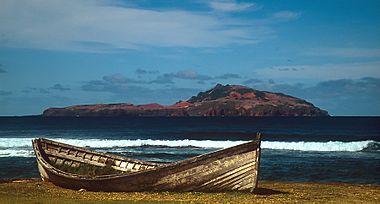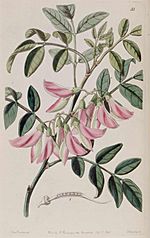Phillip Island (Norfolk Island) facts for kids
Phillip Island is a small island located about 6 kilometers (4 miles) south of Norfolk Island. It is part of the Norfolk Island group in the Southwest Pacific Ocean. In 1788, Lieutenant Philip Gidley King named the island after Arthur Phillip, who was the first Governor of New South Wales. Phillip Island is part of the Australian external territory of Norfolk Island. It is also included in Norfolk Island National Park, just like nearby Nepean Island and a small part of Norfolk Island itself.
A small group of about four people lives in a hut near the island's center for much of the year. Otherwise, the island is not inhabited.
Contents
About Phillip Island
Phillip Island covers an area of 190 hectares (470 acres). It measures about 2.1 kilometers (1.3 miles) from west to east and 1.95 kilometers (1.2 miles) from north to south. The highest point on the island is called Jacky Jacky, which is 280 meters (919 feet) above sea level. The island is roughly shaped like a hairdryer.
Phillip Island was formed by volcanoes. It is made of volcanic rock called basaltic tuff and lava. These rocks date back to the Miocene epoch, which was millions of years ago. Phillip Island is listed on the Register of the National Estate because of its importance.
Plants and Animals of Phillip Island

Plants of Phillip Island
The plants on Phillip Island were badly damaged a long time ago. This happened when animals like pigs, goats, and rabbits were brought to the island during Norfolk's time as a penal colony. These animals ate most of the plants. This caused a lot of soil to wash away, making the island look reddish-brown from Norfolk Island.
However, the pigs and goats were removed by the early 1900s. The rabbits were completely removed by 1988. Since then, the island's environment has greatly improved. Native plants have started to grow back naturally. Park staff have also worked hard to replant areas.
Many areas that were bare before the rabbits were removed are now covered in plants. Even though some are weeds, the speed at which plants and soil have returned is amazing. Seabirds that nest in burrows now have places to live where there was no soil before.
In the late 1980s, the RAAF helped replant Norfolk Island pine trees on Phillip Island. A C130E Hercules aircraft from No. 37 Squadron dropped many Norfolk Island pine seeds onto the island from the air.
Phillip Island has about 80 different types of vascular plants. Three plant species grow only on Phillip Island and nowhere else in the world. One, (Achyranthes margaretarum), was found after the rabbits were gone. All of these plants today came from that single original plant. Another, (Abutilon julianae), was rediscovered when the rabbits were almost gone. People thought this plant had been extinct for over 70 years! The third plant unique to this island is the (Hibiscus insularis).
Animals of Phillip Island
Even though the island's environment was damaged, some animals survived there. This is because there were no wild cats or rats on the island. These animals had become extinct on Norfolk Island. However, some species, like the Norfolk kaka, are now extinct on both islands.
Two types of reptiles live on Phillip Island. These are a gecko called (Christinus guentheri) and a skink called (Cyclodina lichenigera). The island is also a very important place for 12 different types of seabirds to breed. These include the providence petrel, Kermadec petrel, white-necked petrel, black-winged petrel, wedge-tailed shearwater, Australasian gannet, sooty tern (also known as the whale bird), red-tailed tropicbird, and grey noddy. People traditionally collect sooty tern eggs during certain seasons.
BirdLife International has named Phillip Island an Important Bird Area (IBA). It is separate from the Norfolk Island IBA. This is because it has growing numbers of providence and white-necked petrels. It also has more than 1% of the world's population of grey noddies.
See also
 In Spanish: Isla Phillip (Norfolk) para niños
In Spanish: Isla Phillip (Norfolk) para niños



